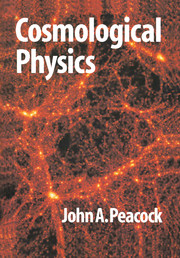Book contents
- Frontmatter
- Contents
- Preface
- Part 1 Gravitation and relativity
- Part 2 Classical cosmology
- 3 The isotropic universe
- 4 Gravitational lensing
- 5 The age and distance scales
- Part 3 Basics of quantum fields
- Part 4 The early universe
- Part 5 Observational cosmology
- Part 6 Galaxy formation and clustering
- Hints for solution of the problems
- Bibliography and references
- Useful numbers and formulae
- Index
3 - The isotropic universe
Published online by Cambridge University Press: 05 June 2012
- Frontmatter
- Contents
- Preface
- Part 1 Gravitation and relativity
- Part 2 Classical cosmology
- 3 The isotropic universe
- 4 Gravitational lensing
- 5 The age and distance scales
- Part 3 Basics of quantum fields
- Part 4 The early universe
- Part 5 Observational cosmology
- Part 6 Galaxy formation and clustering
- Hints for solution of the problems
- Bibliography and references
- Useful numbers and formulae
- Index
Summary
The Robertson–Walker metric
To the relativist, cosmology is the task of finding solutions to Einstein's field equations that are consistent with the large-scale matter distribution in the universe. Modern observational cosmology has demonstrated that the real universe is highly symmetric in its large-scale properties, but the evidence for this was not known at the time when Friedmann and Lemaître began their pioneering investigations. Just as Einstein aimed to write down the simplest possible relativistic generalization of the laws of gravity, so cosmological investigation began by considering the simplest possible mass distribution: one whose properties are homogeneous (constant density) and isotropic (the same in all directions).
isotropy implies homogeneity At first sight, one might think that these two terms mean the same thing, but it is possible to construct universes that are homogeneous but anisotropic; the reverse, however, is not possible. Consider an observer who is surrounded by a matter distribution that is perceived to be isotropic; this means not only that the mass density is a function of radius only, but that there can be no preferred axis for other physical attributes such as the velocity field. This has an important consequence if we take the velocity strain tensor ∂vi/∂xj and decompose it into symmetric and antisymmetric parts.
- Type
- Chapter
- Information
- Cosmological Physics , pp. 65 - 100Publisher: Cambridge University PressPrint publication year: 1998



